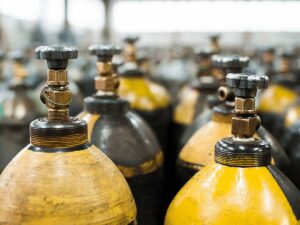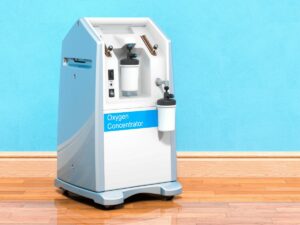How can diverse oxygen therapies upgrade your service offerings? Discovering these techniques promises significant advancements in healthcare and recovery services.
With years of expertise in hyperbaric technologies, I guide industries in harnessing the power of oxygen therapy for enhanced outcomes.
Get a glimpse into the top 2 of the exciting oxygen therapy types that we’ll be exploring:
- Compressed Oxygen Gas
- Liquid Oxygen
In this guide, we will delve into the specifics of 6 oxygen therapy types, each offering unique benefits and applications that can elevate patient care and enhance recovery across various settings.
Read on to explore the world of possibilities!
1. Compressed Oxygen Gas
Compressed oxygen gas stands out as a versatile and essential type of oxygen therapy, widely used across various medical scenarios for its reliability and effectiveness. Here are the factors that underscore its significance in oxygen therapy:
- High Oxygen Concentration: Compressed Oxygen Gas provides a high concentration of oxygen, making it highly effective for treating patients with respiratory distress. This capability is vital in emergencies where rapid response is crucial.
- Portability: Its compact and portable nature allows for easy transportation and use in different settings, from hospitals to outdoor emergency sites. Amazing, isn’t it? This versatility guarantees oxygen therapy can be administered wherever it’s needed.
- Ease of Use: The setup for delivering oxygen from compressed gas cylinders is straightforward, enabling quick initiation of therapy. This simplicity is critical in high-pressure situations where time is of essence.
- Adjustable Flow Rates: The ability to adjust flow rates with precision allows healthcare providers to tailor oxygen delivery to the specific needs of each patient. This flexibility lets patients receive the right amount of oxygen for their condition.

2. Liquid Oxygen
Liquid oxygen is recognized for its high oxygen purity and efficiency, offering a compact and longer-lasting oxygen supply for therapeutic uses. Below are the aspects that describe liquid oxygen as a distinguished type of oxygen therapy:
- Higher Oxygen Density: Liquid oxygen has a much higher oxygen density compared to its gaseous counterparts. For instance, this efficiency is especially beneficial in settings where space is at a premium, making it able for transport and storage.
- Longer Duration: Due to its concentrated form, liquid oxygen systems can provide oxygen therapy for a longer duration without the need for frequent refills. This is a game-changer for patients requiring continuous oxygen, enhancing their quality of life.
- Rapid Gasification: Liquid oxygen rapidly converts to gas when released, supplying breathable oxygen immediately upon demand. This quick conversion is crucial because patients receive oxygen therapy promptly when needed.
- Adjustable Delivery Systems: Liquid oxygen equipment often comes with adjustable delivery systems for precise control over the oxygen flow rate. This adaptability guarantees that individuals receive the optimal amount of oxygen for their condition.

3. Oxygen Concentrators
Oxygen concentrators are innovative devices that extract oxygen from ambient air, providing a continuous, concentrated supply of oxygen for therapeutic use. In this section, we will explore the features that make oxygen concentrators an essential type of oxygen therapy:
- Self-Sufficient Oxygen Supply: Oxygen concentrators do not require refills as they draw oxygen from the surrounding air. This self-sufficiency means patients can rely on a consistent oxygen supply without worrying about running out.
- Versatility and Mobility: Modern oxygen concentrators are available in portable models that allow patients to maintain their mobility and lifestyle. And the best part is, these devices can be used on the go, letting patients receive oxygen therapy wherever they are.
- Adjustable Oxygen Flow: The ability to adjust the flow rate of oxygen allows oxygen delivery according to the patient’s needs. This customization guarantees optimal therapy outcomes for a wide range of respiratory conditions.
- Energy Efficiency: Oxygen concentrators are designed to be energy-efficient, operating on standard electrical power. How awesome is that? Their efficiency makes them an eco-friendly option for long-term oxygen therapy.

4. Hyperbaric Oxygen Therapy
Hyperbaric oxygen therapy (HBOT) involves breathing pure oxygen in a pressurized room or chamber, that enhances oxygen absorption in the body. Data Bridge Market Research reported that its market size is expected to grow at a CAGR of 9.40% from 2023 to 2030, highlighting its importance in today’s world. Let’s explore below what makes HBOT an effective oxygen therapy:
- Enhanced Oxygen Delivery: HBOT increases the amount of oxygen that blood can carry, facilitating the repair and regeneration of tissues faster. Oxygen-ark specializes in providing hyperbaric chambers that can speed up healing processes in damaged tissues
- Improvement in Neovascularization: HBOT stimulates the formation of new blood vessels, which is essential for areas with reduced blood flow. It gets better, this can lead to improvements in conditions where blood flow has been compromised.
- Boosted Immune Response: By increasing oxygen levels in the blood, HBOT helps to strengthen the body’s immune system. And I’m not stopping there; this enhanced immune response is critical for patients with compromised immune systems.
- Reduction of Edema: HBOT has been shown to reduce edema by decreasing the size of the bubbles of gas that may form in the blood. This reduction in swelling can significantly improve the patient’s comfort and the effectiveness of other treatments.
5. Portable Oxygen Therapy
Portable oxygen therapy offers patients the flexibility to receive oxygen treatment outside of traditional medical settings, enhancing their mobility and quality of life. Let’s explore some of the essential features that make portable oxygen therapy a needed option:
- Mobility and Independence: Portable oxygen therapy devices allow patients to move freely and maintain an active lifestyle. Oxygen-ark supports the physical well-being of patients by offering a range of portable oxygen solutions.
- Variety of Options: From lightweight canisters to portable concentrators, there’s a range of devices to suit different needs and lifestyles. But wait, there’s more, each device is designed to offer the optimal balance between portability and oxygen delivery efficiency.
- Adaptability for Travel: Portable oxygen therapy systems are an excellent choice for patients needing to travel while receiving oxygen therapy. And on top of that, they guarantee that patients don’t have to compromise on their oxygen therapy needs.
- Technological Advancements: Modern portable oxygen concentrators are equipped with advanced technology that can adjust the delivery of oxygen based on the patient’s activity level. This adaptability lets patients receive the exact amount of oxygen they need.

6. Transtracheal Oxygen Therapy
Transtracheal oxygen therapy is a specialized form of oxygen delivery that involves a small tube inserted directly into the trachea, providing a direct and efficient oxygen supply. Below is a detailed exploration that defines transtracheal oxygen therapy as an effective type of oxygen therapy:
- Direct Oxygen Delivery: This method delivers oxygen directly to the lungs, bypassing the upper airways, which results in a more efficient use of oxygen. This is important because it can significantly reduce the oxygen needed to achieve adequate blood oxygen levels.
- Reduced Oxygen Waste: By delivering oxygen directly to the trachea, there’s less waste of oxygen compared to traditional nasal cannula delivery. Here’s the bottom line, patients can lead a more active lifestyle with less encumbrance from oxygen equipment.
- Improved Oxygen Saturation: Patients often experience improved oxygen saturation levels with this therapy, enhancing their overall quality of life. It all boils down to this; better oxygenation can lead to increased stamina and less shortness of breath.
- Cosmetic Discretion: The transtracheal catheter is less visible compared to nasal cannulas, offering a more discreet option for oxygen therapy. For example, this can significantly improve the comfort of patients requiring long-term oxygen therapy.
| Aspect |
Transtracheal Catheter |
Nasal Cannulas |
| Visibility |
Less visible |
More visible |
| Comfort |
Enhanced comfort due to discreet placement |
Less discreet, may cause discomfort and irritation |
| Aesthetics |
Provides a more aesthetically pleasing option |
Can be obtrusive and affect appearance |
| Mobility |
Offers greater freedom of movement without visible tubing |
Limits mobility due to visible tubing |
| Social Confidence |
Enhances social confidence with minimal visibility |
May lead to self-consciousness in social settings |
Conclusion
Exploring the diverse world of oxygen therapy opens up a field of possibilities for enhancing patient care and treatment outcomes. This guide provides a comprehensive look at the options available, aiding in the decision-making process for the best oxygen therapy solution.
For businesses eager to delve deeper into oxygen therapy options, Oxygen-ark offers expert advice and solutions tailored to your needs. For more information and a detailed discussion, feel free to contact us.



